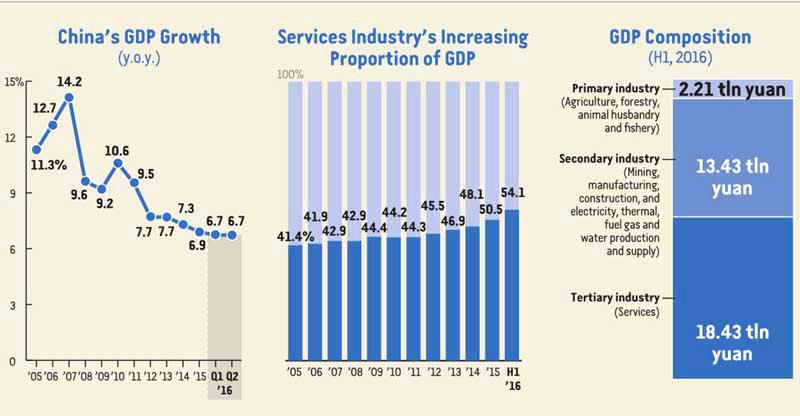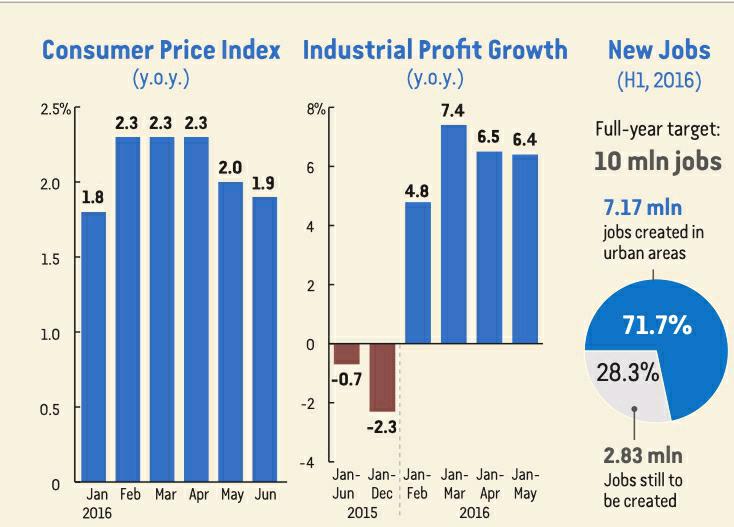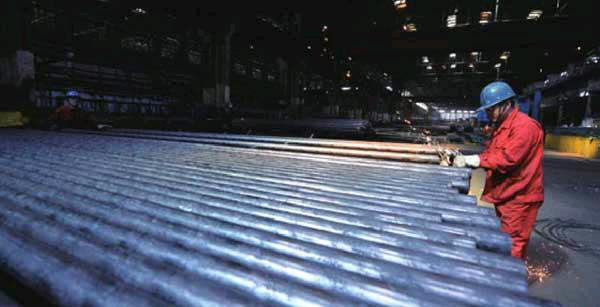Steady Hand On the Tiller
2016-08-17ByDengYaqing
By+Deng+Yaqing
Investors and international observers breathed an audible sigh of relief on July 15 when China announced its GDP growth had leveled out at 6.7 percent in the first half of the year. While economy doomsayers had been battening down the hatches, fearing the worst, the news dispelled global concerns of a further slowdown or even a hard landing.
“The national economy has realized moderate but stable and sound growth, laying a solid foundation for achieving the fullyear goal of 6.5 to 7 percent growth,” said Sheng Laiyun, spokesman of the National Bureau of Statistics (NBS), citing the impact of downward pressure under the currently complex and tough domestic and overseas economic circumstances as a contributing factor for the less-than-stellar growth.
Amidst the fragile global recovery and gloomy trade climate, it has not been easy for China to achieve such stable growth. Despite the ongoing supply-side structural reform and intensified measures tackling“zombie companies,” the country shows little signs of a sharp slowdown, which is testimony to the growing internal impetus of its economy, said Tan Haojun, an economic commentator, in an article.
Developments highlights
In the first half of the year, stable progress has been made in economic transformation and upgrading and supply-side structural reform, Sheng noted.
The service industry kept expanding at a relatively fast pace, making up 54.1 percent of GDP in the first half of the year, up 1.8 percentage points from the same period last year.

Whats worth mentioning is that the hi-tech industrial and equipment manufacturing sectors respectively grew 10.2 and 8.1 percent—accounting for 12.1 and 32.6 percent of the total industrial value-added output—and the strategic emerging industries expanded 11.8 percent in the second quarter, 1.8 percentage points faster than in the first quarter.
Xu Hongcai, Director of the Economic Research Department at the China Center for International Economic Exchanges, suggested that the rapid expansion of the strategic emerging industries came from investment growth. While investment in the manufacturing sector slowed down, in the service sector it maintained a double-digit growth rate.
That meets the demand of industrial transformation and upgrading, and accords with the trend of striding toward the middle and higher end of the industrial chain, said Xu.
According to statistics from the NBS, in the first half of the year, investment in the service sector and hi-tech industry increased 11.7 and 13.1 percent year on year respectively, with it growing 22.5 percent in information technology services.
Despite that, given the current scale of the new economy, its high-speed growth is not enough to offset the impact of the gliding traditional economy. However, if the new economy can maintain momentum, its bound to play a positive role in wrenching the economy out of the future slowdown, said Xu.
Aside from that, consumption contributed 73.4 percent to economic growth, up 13.2 percentage points year on year.“Domestic demand is still the pillar propping up Chinas growth, and consumption is playing a larger role in it,” Sheng noted.
At the same time, industrial value-added output in central and western regions respectively grew 7.3 and 7.2 percent and outpaced eastern region by 0.9 and 0.8 percentage points.
“Amidst the structural adjustment and transformation, central and west China have showed a strong late-starting advantage,”said Tan.
Another important highlight of economic development is the recovery of industrial data, indicating that industrial production is stable and sound, said Xu, who argued the faster growth of industrial value-added output in the second quarter indicates that efforts in cutting overcapacity and de-stock- ing have yielded some results. Industrial value-added output grew 6 percent during the first half, 2 percentage points higher than in the first quarter.
In addition, energy consumption per unit of GDP went down by 5.2 percent year on year, indicating the continual progress made in energy saving and emissions reduction, according to Sheng.
Employment also remained steady during the first half. According to statistics from the Ministry of Human Resources and Social Security, a total of 7.17 million jobs were created in urban areas, completing 71.7 percent of the full-year target. Meanwhile, the unemployment rate in major cities, by and large, remained at roughly 5.2 percent.
“Currently, China is under great downward pressure. However, under such adverse conditions, the nation still scored well in[achieving] employment [targets] because its service industry is undergoing rapid expansion,” said Yao Jingyuan, a research fellow from the Counsellors Office of the State Council.
